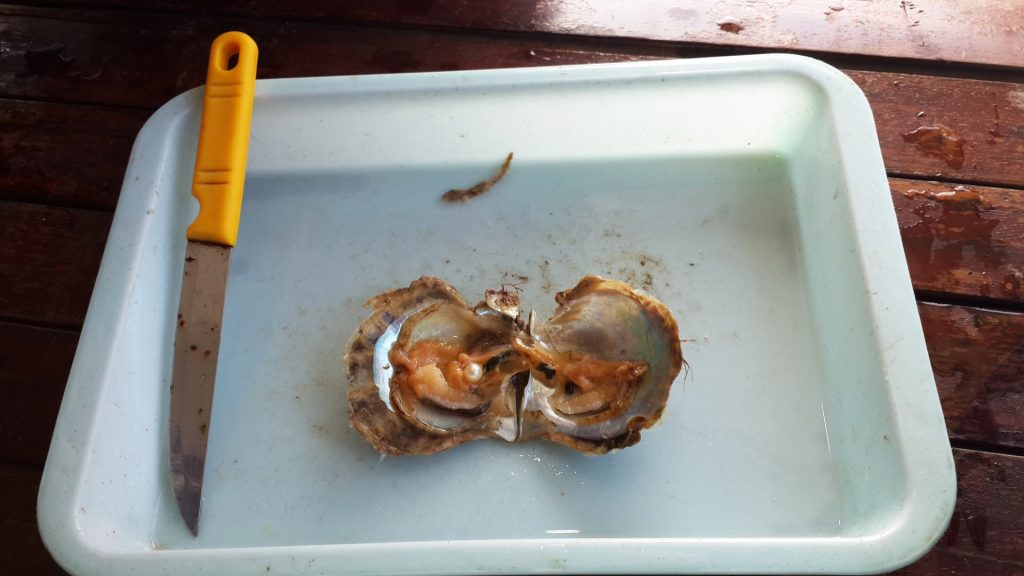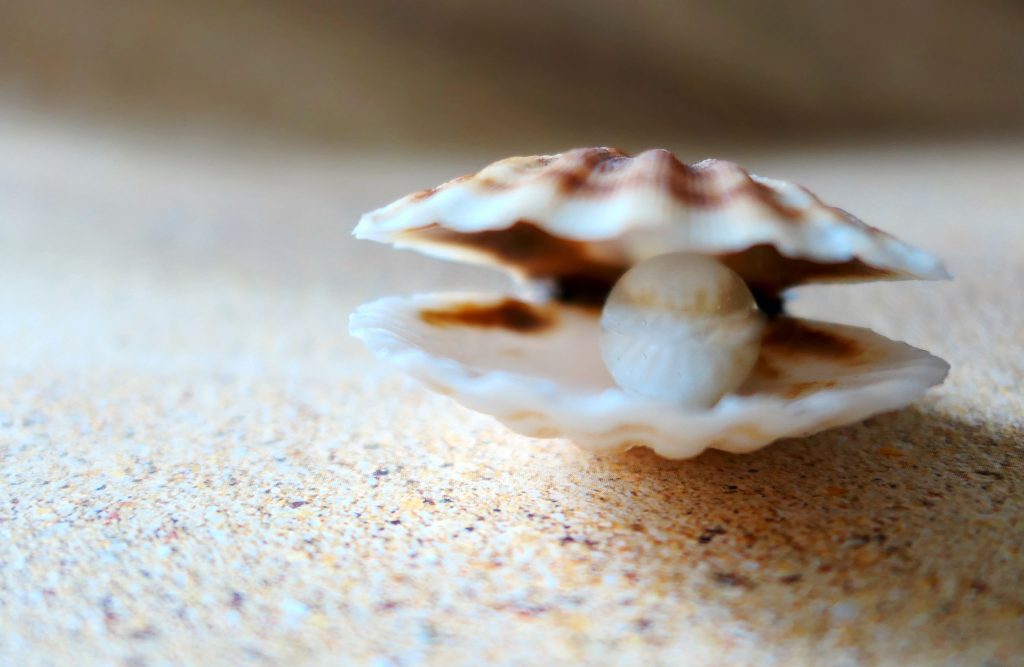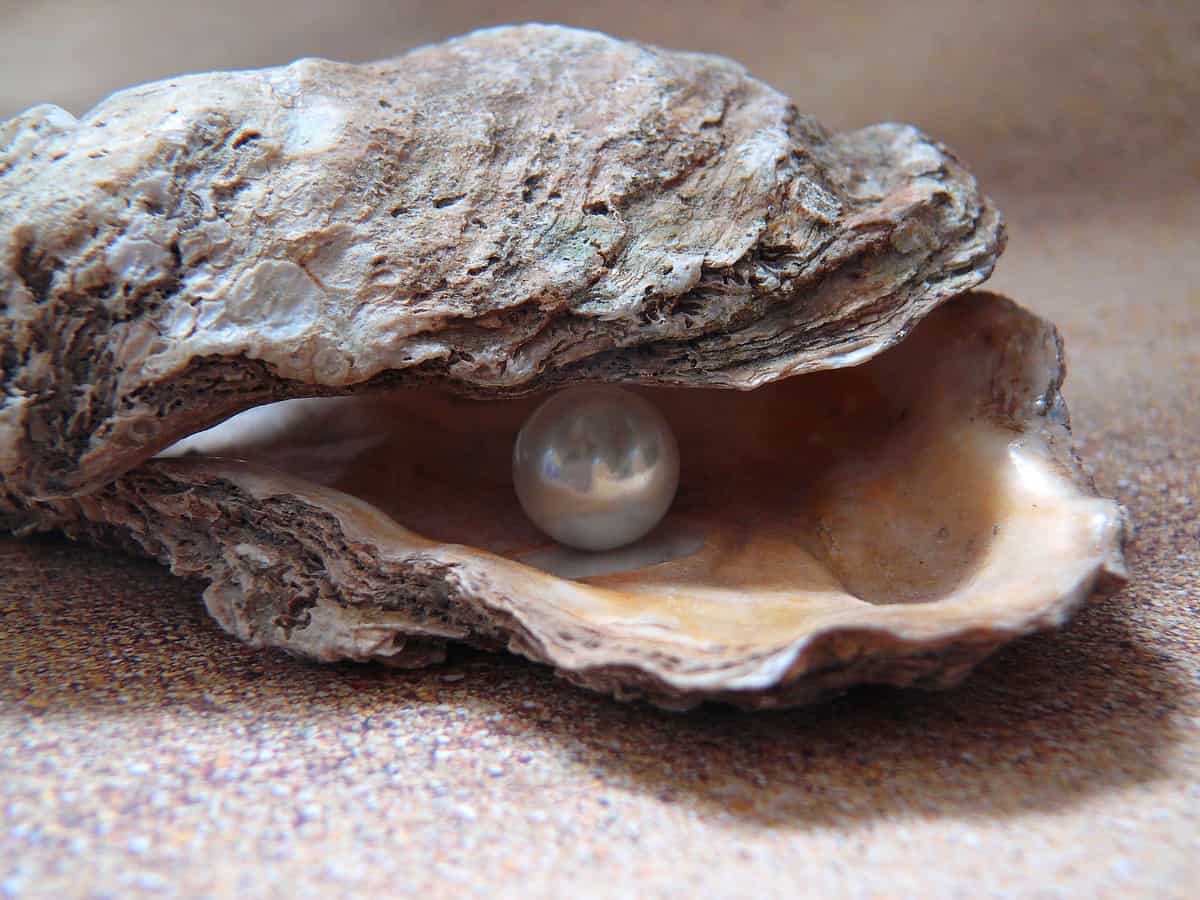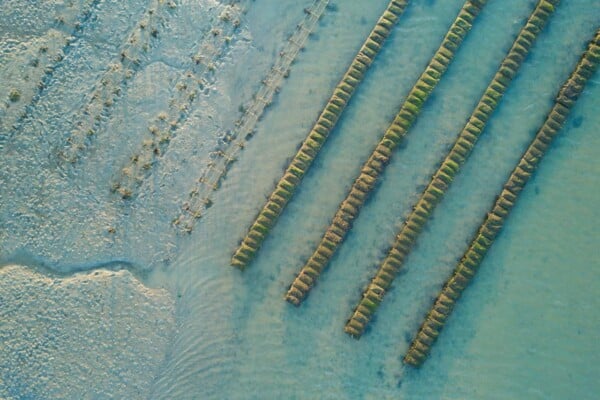Precious and coveted jewelry items, which have become the object of a prosperous and profitable industry today, pearls are, above all, nature’s creations. Nothing could have existed – neither the jewelry, nor the metaphors involving the pearl, nor the millions of dollars – if the natural process had not existed first: some species of mollusks acquired, during evolution, the ability to isolate a foreign object, penetrated their body, by surrounding it with layers of mother of pearl and thus rendering it harmless. Does it sound boring? Not at all, it’s all so fascinating. The result of this normal physiological defense process is the magnificent composition called a pearl.
The genesis of a pearl begins with a banal – and unpleasant – fact. One day, a fragment of foreign organic matter or a parasite reaches the body of the mollusk; or an accidental injury causes a tissue fragment in the lining to reach another part of the body. Tired of this intruder, of which it can’t get rid of easily (it’s not just like some pebble that gets stuck in a shoe), the mollusk has learned, over time (hundreds of millions of years to be more precise) a proper method to mitigate the disturbing sensation: it covers the foreign object with layers and layers of a smooth, calcareous matter, thus isolating it and rendering it harmful, transforming it into an inert, rounded, less irritating formation for soft tissues and which, even if it can’t be eliminated, at least it’s easier to bear.
Most mollusks possess this defense mechanism so that most can produce calcareous formations of different shapes, which can be considered pearls in a very broad sense of the term. Most of them have no commercial value – they are small limestone formations without an attractive appearance, without gloss, and they are of interest only to scientists or collectors, as curiosities of nature.
What we call a “pearl” as jewelry – silky and glossy formations – are produced by a small number of bivalve mollusks (“oysters“, as they are popularly called) that have the particularity of secreting a material with a special structure, which also forms inside the shell: the mother of pearl. The same material is used by the oyster to insulate the irritating foreign objects, thus protecting the pearl.

What is pearl farming?
Pearl farming can be defined as the industry responsible to produce pearls through the grafting of pearl oysters and thus producing cultured pearls. Cultured pearls make up almost all the pearls sold on the market today.
Just like any other type of culture, pearl farming depends on environmental conditions and luck. Sometimes pearl farmers can obtain a very good yield and sometimes they may lose all their oysters, or the quality of the harvested pearls is not as good as it should be to have a high commercial value. Severe storms, excessive heat, and water pollution are just some of the factors that can influence the result of a pearl oyster culture and unfortunately, farmers can’t avoid these risks even with all the prevention measures they take.
In the past, oysters were simply collected from the ocean and people used to look for pearls and finding a natural pearl rarely happened. Now, modern pearl farming involves farmers growing their oysters on special farms. The sperm and eggs of high-quality oysters are collected and so a new generation of oyster larvae is created. The larvae float freely in the water until they are a few weeks old and they attached themselves to collectors. Collectors are used because, in the wild, oysters attach themselves to rocks or other formations during their growing phase.
The larvae are then moved into a controlled environment where they grow until they turn into baby oysters and are tended until they are 1-2 years old and they can be nucleated. The nucleation process differs depending on the type of oysters. Saltwater oysters are nucleated by using a bead made from mother of pearl surrounded by some mantle tissue from a donor oyster. The bead is placed in the gonad. Freshwater oysters are usually nucleated without using a bead. The mantle tissue is placed in the mantle of the gonad and the process can be done on both sizes. Freshwater oysters can produce up to 24-32 pearls per culturing cycle.
After nucleating, some oysters may reject the implanted foreign object and can even die. However, most of them will recover after the procedure and start forming the pearl.
Eco-friendly pearl farming
Because of the rudimentary practices used in the past for pearl harvesting, some mollusk species came to the point of being extinct. The over-exploitation of oysters and mollusks stocks was very damaging for the marine life. For example, the so-called “pearl rush” that happened during the 19th century on the Mississippi River led to a decreasing of the oyster stock near to extinction. Millions of oysters were killed during the process not only because of the hunt for pearls but also because the shells were used to make buttons and other decorative objects.
Therefore, an eco-friendly approach was necessary. Pearl farming has developed as a stand-alone industry, in which pearl oysters are specially grown for harvesting pearls and the harvesting process itself is done with much more care. Also, instead of simply disposing of the oysters after harvesting, some farmers have found ways to make use of the meat of the oysters, which is usually consumed locally. Unfortunately, pearl oyster species are not in demand on the fresh oyster meat market so it’s difficult to find a purpose for the oysters that need to be sacrificed after harvesting, but it’s not impossible.
Eco-friendly pearl farming is possible where pristine and thriving ecosystems exist because the water quality is the main factor that influences the high pearl yield as it provides the oysters with the necessary nutrients for healthy growth. Unsustainable oyster stock densities harm the environment, so pearl farming needs to be done with good measure, depending on the environmental conditions. Otherwise, the marine life can be affected as much as it would be from pollution or human impact.
When good pearl farming practices are used, it can have a beneficial impact on the environment, even considering the biodiversity threats faced by the oceans and rivers on our planet. Pearl oyster farms contribute to the healthy development of many fish species, which can help sustain biodiversity and provide nutrients for the oysters. It’s a win-win situation both for the pearl farms and for marine life. Fish consume the encrusted organisms that are accumulated on the shells of the oysters and smaller fish can also use them as hiding places from other natural predators.
Not only the environmental impact can be a beneficial one, but pearl farming also has a positive impact on local economies. It provides job opportunities for locals and they will not need to rely so much on other activities such as fishing. Pearl farmers also need to take care of the environment where they grow their oysters whether they like it or not because a healthy environment is a key to harvesting high-quality pearls.

Natural pearls vs. fake pearls
A natural pearl is made up of concentric layers of aragonite, a form of calcium carbonate crystallized in the form of hexagonal plates, with a thickness of 0.5 microns, consolidated by thin layers of a protein called conchiolin.
Naturally formed pearls, following the accidental penetration of a foreign object into the shell of the oysters, are rarely found, hence the exorbitant prices for which they are traded.
In the 20th century, when the foundations of industrial-type production were laid, the pearl market was flooded with cultured pearls, much cheaper than the “wild” ones. Pearl farming is based on a combination between human intervention and the natural process of depositing the layers of mother of pearl around a foreign object, the human intervention consisting in the introduction into the soft tissues of the oyster of that foreign body.
Cultured pearls, even if produced in large quantities, are not, however, easy to obtain. Oysters need years to make a pearl – the more years, the bigger the pearl. Only about 5% of the cultured pearls are of high quality, having almost perfect sphericity and iridescent gloss that make them suitable for use in the luxury jewelry industry. Natural pearls can be distinguished from those of culture by X-ray examination.
Large quantities of pearl imitations, made by technological processes, not grown in mussels, circulate on the market. Some are made of other natural materials (such as pieces of mother of pearl from shells and sanded as spherical beads); others, such as the so-called Majorica pearls, are glass spheres covered with several layers of oriental essence – a mixture that contains, among other things, fish scales that give the glossy appearance, in an attempt to mimic the appearance of true pearls.
A small number of oyster species produce pearls of commercial value and are therefore grown on pearl farms:
- Marine species of the genus Pinctada – approximately 6 commonly exploited species; they live in the Mediterranean Sea, the Red Sea, in the warm regions of the Indian, Pacific, and Atlantic Oceans.
- Species of the genus Pteria, also marine – a pearl shell usually produces a single pearl at a time.
- Freshwater oyster species of the genus Hyriopsis (in Asia) and Amblema (in North America); in these species, a single shell can produce several pearls at once – even over 20.
Another species historically known for the beautiful pearls it produces (and from which it also received its scientific name) is Margaritifera margaritifera, a freshwater shell from Europe and North America, unfortunately, threatened with extinction and becoming today the object of some protection programs.
Different species produce pearls of different shades – from white to yellow-gold (in the Philippines), from pink to dark-gray, very expensive, known as “Tahitian black pearls”.
Obtaining pearls through pearl farming
Currently, cultured pearls are obtained, in broad lines, by two processes: one that uses only tissue fragments inserted in the oyster, often obtaining pearls of irregular shape; another in which, next to the tissue fragment, a small round bead is inserted, around which the oyster will deposit the mother of pearl, the result being a pearl closer to the spherical shape – the most precious in the jewelry industry.
Occasionally, beads of another form are used, which the oysters cover with mother of pearl, resulting in cultured pearls with more unusual patterns.
Pearl farms exist especially in Asian countries, both for freshwater and “sea” pearls.
The nucleated oysters are raised in water, using some nets. After 2-5 years from nucleating – depending on the species and the type of pearls pursued – they are removed and taken to the harvesting room. Here they are carefully “operated” by removing the pearls, and then the surviving oysters can be sown again and put back into the water, for a new production cycle.
The method has a very good yield, unlike the primitive method used for centuries to harvest natural pearls. Millions of oysters gathered from the sea were brutally opened, with knives (and thus killed), to find a pearl – which rarely happened.
Pearls obtained from marine pearl farms, raised in lagoons or bays, are more expensive than freshwater ones, for an objective reason: a marine pearl shell can be seeded with only a single piece of tissue (which triggers the formation process), attached to a small polished sphere, made of oyster shells will, therefore, produce a single pearl.
In contrast, freshwater pearl oysters are more productive: multiple seeding will result in the formation of more pearls in the same shell. Approximately 90% of the pearls marketed today are cultured pearls, the market is dominated by freshwater pearls obtained in China.
The most valuable pearls come from the Bahrain area and the Persian Gulf, but high-quality pearls are also obtained from the Red Sea, the Indian Ocean, and the Pacific, and more specifically: India, Australia, the Philippines, Japan, Mexico, and Venezuela.
One of the largest producers of natural cultured pearls is Japan. The first cultured pearls were obtained in 1898, but they were only patented in 1907 by two Japanese, Mikimoto Kokichi and Tokichi Nishikawa. Interestingly, the two made these discoveries simultaneously, but without knowing of each other or knowing the works that each develops.
There are also natural freshwater pearls, produced inside the oysters that live in North Europe, North America or China. The most valuable freshwater pearls come from the United States and were discovered by English colonists. These were worn by the natives of the Ohio, Mississippi and Tennessee regions. Some of these pearls were so perfect that they could easily be mistaken for Asian saltwater pearls.
Not only oysters make pearls
Although the most popular, appreciated and marketed pearls are those produced by the aforementioned oysters, there are still some species of mollusks – this time snails – that produce less common pearls, rarely used, but which have aesthetic and even commercial value, for those who know how to value them.
The pearls of these snails are not, in general, pearls, but they have a very special appearance – they are made of porcelain, with a fine gloss and in delicate colors – pastel shades of yellow, pink or orange.
The large snails Melo melo (from the Indian Ocean) and Strombus gigas (from the Atlantic) produce such rare pearls.
And as we live in a world passionate about records, you may want to know which is the biggest pearl found so far. Well, for a long time it was a huge white pearl (but without a glossy shine, more porcelain-like) “born” from a huge oyster (of the species Tridacna gigas) and weighing 6.4 kilograms.
It was found in the US, being the private property of several people, the descendants of those who bought it from the heirs of its first American owner – a certain Wilburn Cobb, who in his turn brought it from the Philippines in 1939 and died in 1979.
The pearl – known as “Lao Tzu’s pearl” – has a captivating legend, that it was raised in China and reached this size because over 2,500 years, it has been successfully transferred from one oyster to another. There are some claims that the legends were just stories created by Cobb and the pearl wasn’t even a “real” pearl after all.
However, that record was broken by a pearl found on the coast of Palawan Island, in the Philippines by a local fisherman. The pearl weighs almost 34 kilograms and was valued in 2016 at 100 million US dollars.
It has no value to a jeweler – who could wear such a thing? – but it’s nonetheless extremely precious and it is an impressive testimony of what nature can do, in terms of oysters and pearls.



